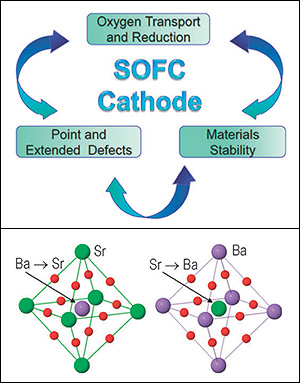News Story
New Approach Will Help Explain and Control Energetic Materials Degradation
A new computational approach that for the first time allows researchers to understand how a material's surface qualities affect its degradation and release of energy during fast chemical reactions has been published in the high-impact Journal of the American Chemical Society (JACS), and was also recently highlighted in the publication's new JACS Spotlights feature.
The work, by Department of Materials Science and Engineering (MSE) adjunct professor Maija Kukla (National Science Foundation) and MSE research scientist Onise Sharia, is novel both in its approach to the ab initio modeling and in its exploration of the specific combination of the morphology of the materials (from the point of initiation) and chemical interactions it explored.
The ability to understand and control the surface properties of materials through the manipulation of their chemical composition is important to many products and areas of research, including energy storage and conversion, biomaterials, sensing, nanotechnology, and pharmaceuticals. While most products require a stable composition, in certain cases a lack of stability in the form of controlled or triggered decomposition is desired, such as in extended release drug tablets or energy-releasing materials such as fuels or explosives.
The nature of these reactions, however, means that our understanding of the processes that initiate decomposition and energy release is lagging behind our need to improve and create products with highly controlled properties. Kukla explains that studies of energetic materials are also complicated by the fact that while several different decomposition reactions may occur simultaneously, current experimental techniques are unable to distinguish between them, and are only able to measure the outcome as a whole.
A complete picture of the decomposition of energetic materials, she says, must include activation barriers (the amount of energy required to trigger the explosive chemistry) and the kinetics of those reactions (the rate at which they proceed). Previously such experimental studies had only been performed, with difficulty, on isolated molecules, and were "impossible to perform" on solid-state materials (even those with an ideal crystal structure) and for materials whose surfaces contained voids, particles of varying sizes, deformations or other defects that would have an impact on energetic reactions.
Using a widely studied and well-defined explosive called HMX as their model material, Kukla and Sharia created quantum chemical simulations to determine the relationship between the material's morphology (form and structure) and its mechanism of decomposition. Their results can be applied to other complex materials, allowing researchers to comprehensively and accurately describe the earliest stages of high-speed, energy-releasing chemical reactions for the first time.
"We were able to connect several theories and sophisticated methods [to achieve the] realistic modeling of chemical reactions in very complex materials," says Kukla. "The computational and theoretical challenge was to connect those existent theories and apply them to a specific practical—yet fundamental—problem of modeling fast chemistry in materials."
Kukla describes the modeling technique as a "breakthrough" with applications beyond the study of energetic materials. "It is possible," she says, "to extend the approach we used to any kind of materials or complex systems."
For More Information:
Onise Sharia and Maija M. Kuklja. Rapid Materials Degradation Induced by Surfaces and Voids: Ab Initio Modeling of β-Octatetramethylene Tetranitramine." J. Am. Chem. Soc., 2012, 134 (28), pp 11815–11820. Abstract »
Published September 25, 2012











